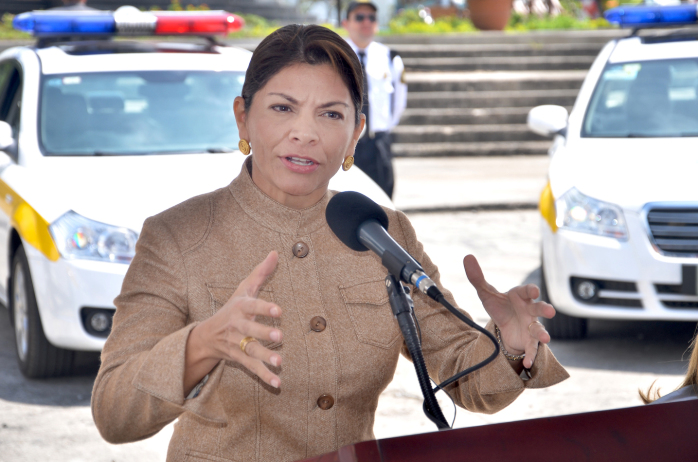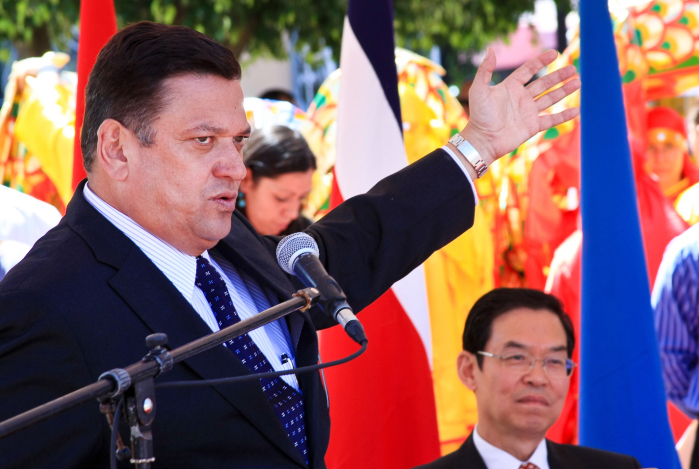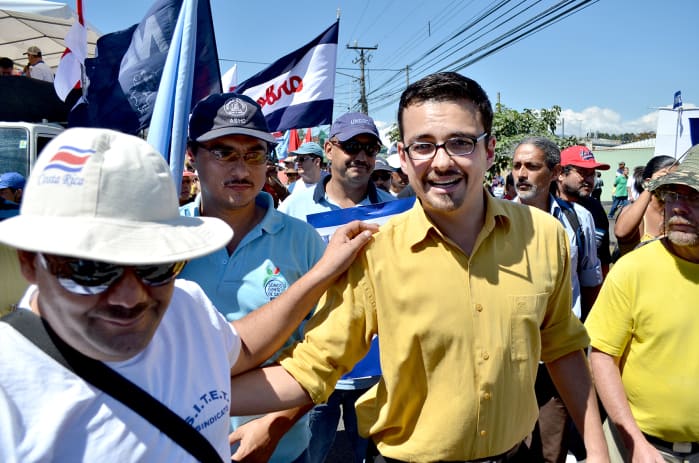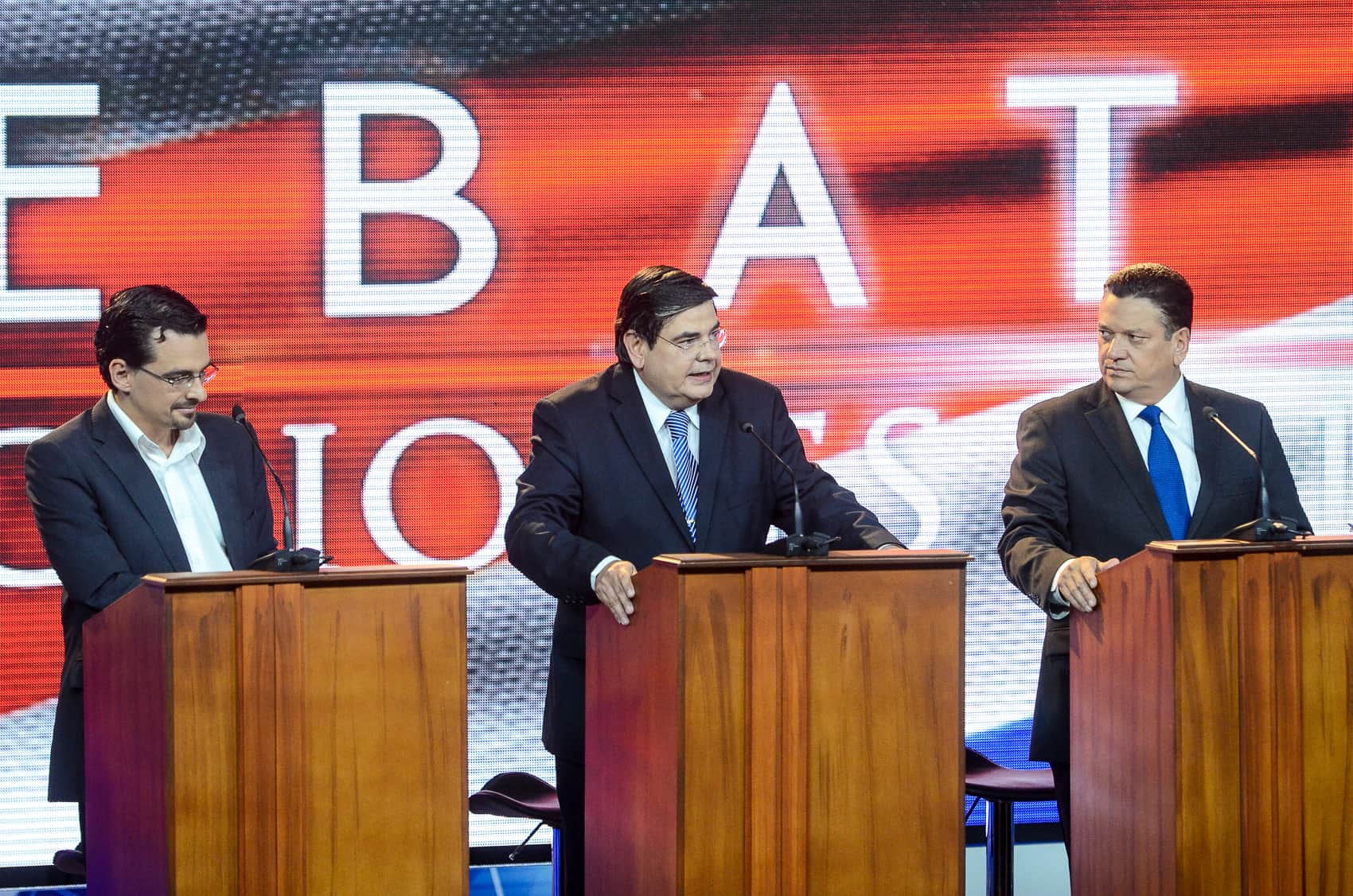Costa Rica now faces what would have been an unthinkable proposition a year ago – a new political party taking over the government.
At the beginning of 2013, the longtime San José mayor, Johnny Araya, seemed destined to lead the National Liberation Party (PLN) to another election victory on Feb. 2. The ruling party had the presidency and more seats than any party in the Legislative Assembly – 24. It also held 58 of 80 mayoral offices.
The progressive Broad Front Party (FA) had one elected official, San José lawmaker José María Villalta. Its founder, José Merino del Río, died in October 2012. Its 2010 presidential candidate won less than 1 percent of the vote. Yet the Broad Front Party could end a more than 50-year dominance by Costa Rica’s traditional political parties.
What happened?
The mayor and the president
From January to September 2013, Araya was the strong front-runner whose presidency seemed inevitable, according to polls and media coverage. Two factors worked in Araya’s favor: His 21-year reign as the capital city’s mayor and the collapse of the PLN’s most substantial rival in the last half century, the Social Christian Unity Party (PUSC).
Despite these advantages, Araya began his campaign knowing that one albatross would dangle from the neck of any PLN candidate – Laura Chinchilla and both current and former members of her administration. Met with jubilation when she became Central America’s Costa Rica’s first woman head of state in 2010, Chinchilla had become the country’s least popular president in the history of polling, and Latin America’s least popular head of state by 2013. Costa Ricans viewed her administration as one part incompetent, with low economic growth, rising debt, high unemployment and growing social inequality, and and a second part corrupt, with 15 ministers resigning by June 2013.
“It’s evident that people see the difference,” Araya said last September, according to the daily La Nación, one month before his poll numbers began to slip. “They criticize the government but they put me as the favorite. Right now the people see the candidate more than the party.”
Before last October, Araya’s campaign strategy had seemed effective. He campaigned on a trans-partisan message of national unity. And he collected the endorsements of politicians from other parties, such as various mayors, former PUSC lawmaker Luis Fishman and Accessibility Without Exclusion Party lawmaker Victor Emilio Granados, among others.
“Just one man cannot solve the many problems the country faces,” Granados said in his endorsement, according to news site crhoy.com. “It’s (about) a vision of unity, and the one who has demonstrated that in political life has been Don Johnny.”
In further trying to create daylight between himself and Chinchilla, Araya said he would avoid including members of her Cabinet in his government, instead including some non-PLN politicians. Araya also said he would consider the rival candidate from the Citizen Action Party (PAC), Luis Guillermo Solís, as his foreign minister. Solís and PAC have been among the harshest critics of the PLN during the campaign.
Araya openly criticized the blunders of the Chinchilla administration, including a $524 million highway expansion in the western Central Valley that caused an uproar in April 2013 when drivers learned the tolls would cost $8 on a round trip. Accusations flew that the government granted the project to a Brazilian company in a deal closed to public bidding, and Chinchilla’s new transport minister who sealed the deal – a man whose predecessor was forced to resign over a border-road scandal wrought with corruption – had worked as a private consultant to the same Brazilian company seeking the contract. Araya criticized that concession, suggesting a trust with a state-owned bank as an alternative.
In a similar misstep for Chinchilla, Araya also joined the chorus of criticisms over a petroleum refinery concession with the Chinese government. Plans for the project in Limón, on the Caribbean coast, began under Chinchilla’s predecessor, Óscar Arias, also of the PLN. Critics – including Araya – questioned the benefit the refinery would bring to Costa Rica. The project to modernize a petroleum refinery in Moín was supposed to save the country $40 million to $120 million annually by importing crude oil and then refining it. Cost estimates continued to climb, reaching $1.3 million and raising concerns that Chinchilla’s administration was either lying about previous costs or simply incompetent.
“In Costa Rica it costs too much to do public projects and this was bungled,” Araya said, according to La Nación. “This was not handled well.”

Araya also could not keep silent on Chinchilla’s worst snafu of the year – receiving a ride on a plane with suspected links to a drug trafficker. The president and her entourage used the plane to attend the wedding of one of her vice presidents’ sons on a Colombian-owned aircraft Costa Rican authorities were investigating for suspected drug trafficking. Two officials resigned over the incident. Araya called for an internal PLN investigation.
“It seems to me that there was a recognition that the presidency committed an error,” Araya said, according to La Nación. “Evidently she (Chinchilla) has someone on the team who ought to have verified these things were done correctly.”
During this first chunk of 2013, some stories surfaced that would betray the image Araya was trying to craft – that he was a competent mayor and that he was going to be a clean break from Chinchilla.
Araya stepped down as San José’s mayor in July 2013 and the reviews of his 21-year tenure heaped familiar criticisms on the PLN’s nominee. La Nación ran a critical review beside a photo of garbage in the street.
“The legacy of the ex-mayor of San José, Johnny Araya Monge, is a canton with growing indigence, filth and disorder in the streets, but with green areas, pedestrian streets, festivals and expensive condominiums,” La Nación wrote.
The paper noted that Araya kept only 27 percent of his campaign promises for the 2007-2011 period. PAC lawmakers accused Araya of increasing the city’s debt from $58 million in 2011 to $85.4 million in 2012 – mirroring the national problems on government spending. Chinatown, in the south-central part of the city, suffered from uncollected trash, flooding and additional construction costs. The neighborhood transformation was a joint investment with the Chinese government – drawing parallels with Chinchilla’s refinery project.
Araya also came under fire when he had to turn to the Legislative Assembly to cover an unanticipated debt for hotel expenses in San José’s Central American Games.
Responding to this news, business newspaper El Financiero published a brutal column:
“San José is an ugly city,” libertarian columnist Juan Carlos Hidalgo wrote. “To the point that when foreign friends want to visit Costa Rica, generally I recommend not spending more than one day in the capital. This is in great contrast to other capitals and Latin American cities where one can see that they have or had competent mayors such as Bogotá, Lima, Medellín and Guayaquil.”
Araya’s campaign broke its earlier promise to not include members of Chinchilla’s government in its campaign. The vice minister of aerial transportation and Araya’s brother joined the campaign in May, and the minister of women’s affairs joined his campaign in July.
In June 2013, Panamanian newspaper La Prensa reported that Araya’s campaign manager, Antonio Álvarez Desanti, bought 685 hectares of protected lands in Panama. The deal enriched a pair of lawyers who had bought the land for substantially less than their sale, according to La Prensa. The report had parallels with Chinchilla’s scandals, where ministers had resigned. An indigenous group in Panama, the Ngöbe, said they were tricked into selling the land, thinking they were making an investment. Álvarez Desanti denied that the business was illegitimate. In an interview with La Nación, he said he was planning to build a $40 million ecologically themed hotel on the protected lands.
Despite some negative coverage, Araya’s campaign maintained a strong lead throughout most of 2013, and more importantly, seemed to have no direct challenger. In October of last year, the simmering issues of PLN and Araya began to boil over.

A challenger appears
During this same stretch from January to September, Villalta became a quote machine for a Costa Rican media seeking a strident government critic. Whether issued from the floor of the Legislative Assembly or in the middle of a street protest, the Broad Front Party candidate appeared in numerous stories blasting the sitting administration.
Villalta slammed, as Araya had, the obvious shortcomings such as the western Central Valley highway and Chinchilla’s plane trip. In what would become a campaign feature, Villalta joined protesters at rallies against the highway project.
When a sea turtle conservationist was murdered in Limón, Villalta accused Chinchilla’s government of negligence. Jairo Mora’s body was found on the nesting turtle beach he patrolled in May. His death sent shockwaves across the environmental community in Costa Rica and abroad, and his group had warned authorities about past threats from poachers.
“It is important to acknowledge that the death of Jairo is not only the fault of these bands of criminals, but also the fault of the state,” Villalta said. “In this case the state did not fulfill its responsibility, and now we need to take actions so that this doesn’t happen again.”
In September, the debt of Costa Rica’s Social Security System, or Caja, rose above $480 million. Villalta said the government had failed to address a problem that had been brewing since 1996. The inability to balance the Caja’s finances was only part of Costa Rica’s rising debt problem. In 2013, the government’s total deficit rose to 5.4 percent of the country’s GDP – approximately $2.3 billion.
These are only a sample of the sundry denouncements Villalta made from January to September in 2013; whenever Chinchilla or her Cabinet erred or whenever statistics revealed poor management, Villalta would reliably appear.
“This represents the discontent due to acts of corruption that every day come to light,” Villalta said in June, according to Teletica. “The abusive concession contracts, where the benefit is sought for small groups that financed the government’s campaigns, the deterioration of life for the working class.”
At the same time, Villalta became a champion for issues that his party framed as “human rights,” and that helped him capture the imagination of a younger generation of Costa Ricans. This was best exemplified in a measure last July in the Legislative Assembly that attempted to open the door for gay partnerships.
Other lawmakers said Villalta slipped language into a bill that prevented discrimination on Costa Rica’s equivalent of common-law marriages. Villalta said he was upfront about the language. Lawmakers who fiercely oppose gay marriage voted for the bill, and when they realized their mistakes, asked Chinchilla to veto it. She didn’t.
When tested in the courts, judges shot down same-sex partnerships, but not before Villalta’s maneuver was the top story in every major news outlet, helping to raise the profile of his presidential bid.
Villalta remained consistent in this vein, challenging socially conservative norms when he asked evangelical lawmaker Justo Orozco to remove himself from the Assembly’s Human Rights’ Commission after Orozco made disparaging comments about homosexuals. Villalta targeted Orozco and conservatives earlier in 2013, when he advocated that Costa Rica’s government should be secular, as opposed to its standing constitutional declaration that Catholicism is the official religion.
In a September debate, Villalta said he supported the legalization of medical marijuana, calling the war on drugs a “complete failure.” By the end of 2013, Villalta has not emphasized this position, though his campaign said he was open to medical legalization.
In media coverage Villalta rose from being the quote in a story criticizing the government to being the main subject.
Days after the July gay-marriage bill, La Nación polled Costa Ricans on which lawmaker they believed was doing the best job. Respondents put Villalta in second place, behind Orozco, the highest-profile lawmaker opposing gay marriage.
In April, the same newspaper ran a glowing profile of Villalta as the intellectual heir of the party’s deceased founder, José Merino del Río. In August, the newspaper ran a profile of the party, which was threatening not just a breakthrough in the presidential race, but at the Legislative Assembly as well.
A pair of polls in September put Villalta in third and fourth place in the presidential race, a crucial moment for a party that had come in seventh in 2010 election with less than 1 percent of the vote.
“I believe that it’s an encouraging result because it shows we are growing in a sustainable way while other parties are stagnant or collapsing,” Villalta said, according to crhoy.com.
Another sign of Villalta and the Broad Front Party’s surge was in the coverage of their ideological enemies. Hidalgo devoted a late-September column to warning his countrymen of the “siren songs” of Villalta. Hidalgo presaged many of the criticisms lobbed against Villalta, such as the candidate participating in a homage for the late Venezuelan socialist Hugo Chávez.
“What exactly is deserving of homage of that figure?” Hidalgo wrote. “Has there been a leader of a government more corrupt in the Americas, according to Transparency International?”

A red October for continuismo
Last October, the PLN celebrated its 62nd anniversary at the National Gymnasium in western San José. Amid the aerial acrobats and green-and-white trimmings, candidate Araya took to the stage to remind the audience of the upcoming battle.
“This is the time to correct errors and to win back the legitimacy that has allowed us to be the principle instrument in the Costa Rican people’s struggle for democracy,” Araya said. “We are conducting a true renovation of our party to face the challenges we will face in the future.”
Continuismo – “continue-ism” or “more of the same” – had become a favorite epithet for opposition candidates such as Villalta and Libertarian Movement Party candidate Otto Guevara to hurl at the 62-year-old dominant party. Despite Araya’s call for renovation, his campaign struck many voters as more of the same.
Costa Rica’s election authority, the Supreme Elections Tribunal (TSE), launched an investigation on what happened outside the gymnasium. The PLN used the public space to hang a giant banner of their smiling candidate. The TSE also investigated whether charitable dental care given by Araya’s wife was a campaign prop – a violation of the country’s Electoral Code. A Costa Rican satirist using Facebook accused the PLN of offering a monthly fee to not attack their candidate.
‘Hire me, please?’
Araya launched his first campaign advertisements under the slogan “Hire me,” with the intended message that he was a humble job applicant. The slogan came under widespread scorn in the traditional media, social media and from his opponents. The tagline struck the wrong tone with voters who had doubts about ethics at the mayor’s office. In December, Araya admitted the ads had failed, and they were quickly scrapped.
La Nación then reported that Araya was the most absent candidate from several early debates, contradicting this humble image. For decades he had stayed out of the limelight as mayor, and his seeming inexperience in handling constant media pressure was becoming apparent. He failed to guess the price of a liter of milk and a casado – the country’s ubiquitous rice, bean and meat dish. At a campaign event in San Carlos, Araya said his party was not populist. In a country facing worsening economic conditions, these undermining events created the appearance of an entitled candidate and party.
Continuismo had a second face, whose October collapse warrants a brief explanation. Before Villalta’s surge, Rodolfo Hernández was seen as Araya’s most formidable challenger. Hernández might have been PUSC’s second coming after the once-dominant party had been entombed by the criminal scandals of former President Rafael Ángel Calderón Fournier (1990-1994) and Miguel Ángel Rodríguez (1998-2002).
Hernández resigned, then rejoined the campaign, then resigned again in a six-day period at the beginning of October. In parting, Hernández accused the party of corruption, sinking any hopes of its reincarnation.
“They thought they could play me, that they could order me around and that my warnings were inconsequential. They were wrong,” Hernández said of his party.
It was only after PUSC’s October collapse that Villalta took the mantle as Araya’s main challenger. On the price of household goods, Villalta came close on the price of rice, though erring on milk’s cost. Villalta said he didn’t drink milk. In contrast to Araya, Villalta had the highest attendance at presidential debates. By early November, Villalta had closed the polling gap with Araya to 7 percent.
Renovation or revolution?
On the first of December, La Nación shocked Costa Rica when it published a poll showing Villalta in first place. Villalta held a technical lead, within the poll’s margin of error, over both Araya and Guevara. It was the first poll to not show Araya in first.
The final two months only reinforced questions swirling around Araya’s candidacy. His campaign website altered Araya’s biography after El Financiero reported that he misrepresented his studies at Harvard University. Economists from the National University declared his pension finance proposals difficult to implement. A viral election video from University of Costa Rica students said that no one should vote for a candidate with the kinds of connections to the past that Araya had.
Villalta’s new status earned him closer scrutiny. The candidate accused Centroamérica Habla of editing a video interview that asked questions about Villalta’s opinion on the Venezuelan regime. Villalta walked back comments on renegotiating a free trade agreement with the United States. The specter of Chávez and the Broad Front Party’s connection to communist parties continued to drive much of the criticism against Villalta.
This January, three recent polls have shown that Araya and Villalta remain as the top two candidates. One poll, CID-Gallup, showed Araya with the comfortable margin of his pre-October days – the possibility of winning in the first round nearly within his grasp. The second poll, from La Nación, indicated a near-guarantee of a runoff, which it predicted Villalta winning. A third poll, from the University of Costa Rica publication Semanario Universidad, fell between these poles. It gave Araya a 5.1 percent advantage over Villalta, but not enough to win in the first round.
Though Villalta has consistently been Araya’s top challenger, Guevara and the Libertarian Movement Party present a challenge from the right side of the political spectrum. Unlike Villalta, Guevara and ML have not exploded in a short span of time. Slowly building his party over three previous presidential runs, the former member of PUSC is in the most competitive position of any of his past runs. The poll in La Nación, which put Guevara in a virtual tie at the top, also said Guevara would defeat Villalta or Araya in a runoff election.
Election polling even entered the realm of conspiracy after La Nación canceled publication of a poll only days before the election. Many Costa Ricans accused the newspaper of spiking the poll because it showed poor results for Araya. The most recent poll by CID-Gallup showed the rise of a fourth challenger who could end up in the runoff – Luis Guilermo Solís of the center-left Citizen Action Party. CID-Gallup has consistently been the pollster showing the highest numbers for Araya, though this result showed a drop in his support over their last survey.
For the candidates, public campaign rallies wrapped up over the weekend. Now, it’s up to the voters to decide on Feb. 2 if Liberation is still their aim.






